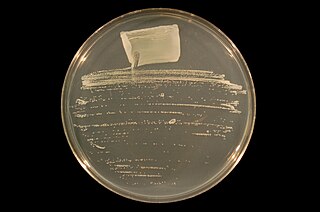
Pseudomonadota is a major phylum of Gram-negative bacteria. The renaming of several prokaryote phyla in 2021, including Pseudomonadota, remains controversial among microbiologists, many of whom continue to use the earlier name Proteobacteria, of long standing in the literature. The phylum Proteobacteria includes a wide variety of pathogenic genera, such as Escherichia, Salmonella, Vibrio, Yersinia, Legionella, and many others. Others are free-living (non-parasitic) and include many of the bacteria responsible for nitrogen fixation.

The Hyphomicrobiales are an order of Gram-negative Alphaproteobacteria.
Burkholderia vietnamiensis is a species of bacteria. It can be found as an opportunistic pathogen in patients with cystic fibrosis or other immunocompromising illnesses. It differs from most Burkholderia species in that it is often susceptible to aminoglycosides, but not polymyxin B. Many isolates have been found to be catalase positive. B. vietnamiensis is able to fix N
2.

Bradyrhizobium is a genus of Gram-negative soil bacteria, many of which fix nitrogen. Nitrogen fixation is an important part of the nitrogen cycle. Plants cannot use atmospheric nitrogen (N2); they must use nitrogen compounds such as nitrates.

Ensifer is a genus of nitrogen-fixing bacteria (rhizobia), three of which have been sequenced.
"Aromatoleum" is a genus of bacteria capable of microbial biodegradation of organic pollutants. It has one single described species member, A. aromaticum, for which the only strain is strain EbN1.

Azospirillum brasilense is a well studied, nitrogen-fixing (diazotroph), genetically tractable, Gram-negative, alpha-proteobacterium bacterium, first described in Brazil by the group of Johanna Döbereiner and then receiving the name "brasilense". A. brasilense is able to fix nitrogen in the presence of low oxygen levels, making it a microaerobic diazotroph. An isolate from the genus Azospirillum was isolated from nitrogen poor soils in the Netherlands in 1925, however the species A. brasilense was first described in 1978 in Brazil, since this genus is widely found in the rhizospheres of grasses around the world where it confers plant growth promotion. Whether growth promotion occurs through direct nitrogen flux from the bacteria to the plant or through hormone regulation is debated. The two most commonly studied strains are Sp7 and Sp245, both are Brazilian isolates isolated from Tropical grasses from Seropedica, Brazil.
Bradyrhizobium liaoningense is a species of legume-root nodulating, microsymbiotic nitrogen-fixing bacterium. It was first isolated from Glycine soja and Glycine max root nodules in China. Its type strain is strain 2281.
Azoarcus evansii is a species of bacteria. Its type strain is KB 740T.
Azoarcus indigens is a species of bacteria. It is a nitrogen-fixing bacteria associated with roots of Leptochloa fusca . Its cells are yellow-pigmented, straight to curved, gram-negative rods. Its type strain is VB32.
Azoarcus olearius is a species of bacteria. It is a nitrogen-fixing bacteria. Its cells are Gram-negative, motile and rod-shaped, surrounded by a thin capsule. Its type strain is DQS-4T.
Azoarcus is a genus of nitrogen-fixing bacteria. Species in this genus are usually found in contaminated water, as they are involved in the degradation of some contaminants, commonly inhabiting soil. These bacteria have also been found growing in the endophytic compartment of some rice species and other grasses. The genus is within the family Zoogloeaceae in the Rhodocyclales of the Betaproteobacteria.
Azoarcus tolulyticus is a species of bacteria. It is a nitrogen-fixing bacteria. It is notable for degrading toluene. Tol-4 is its type strain.
Azovibrio restrictus is a species of bacteria. It is a root bacteria and is the only known species of its genus.
Azospira oryzae is a species of bacteria. It is a root bacteria, one of two species in the genus Azospira along with A. restricta.
Azonexus fungiphilus is a species of bacteria. It is a root bacteria and together with Azonexus caeni is one of the two species in the genus.
Azospirillum halopraeferens is a species of nitrogen-fixing bacteria associated with the roots of Diplachne fusca and black mangrove. It is microaerophilic and its type strain is Au 4.
Xanthobacter agilis is a dinitrogen-fixing, non-pleomorphic hydrogen-oxidizing and motile bacteria from the family of Xanthobacteraceae which has been isolated from a lake near Neuchâtel in Switzerland. Xanthobacter agilis produces o-phthalyl amidase.
Azospirillum is a Gram-negative, microaerophilic, non-fermentative and nitrogen-fixing bacterial genus from the family of Rhodospirillaceae. Azospirillum bacteria can promote plant growth.

Phytobacter is a genus of Gram-negative bacteria emerging from the grouping of isolates previously assigned to various genera of the family Enterobacteriaceae. This genus was first established on the basis of nitrogen fixing isolates from wild rice in China, but also includes a number of isolates obtained during a 2013 multi-state sepsis outbreak in Brazil and, retrospectively, several clinical strains isolated in the 1970s in the United States that are still available in culture collections, which originally were grouped into Brenner's Biotype XII of the Erwinia herbicola-Enterobacter agglomerans-Complex (EEC). Standard biochemical evaluation panels are lacking Phytobacter spp. from their database, thus often leading to misidentifications with other Enterobacterales species, especially Pantoea agglomerans. Clinical isolates of the species have been identified as an important source of extended-spectrum β-lactamase and carbapenem-resistance genes, which are usually mediated by genetic mobile elements. Strong protection of co-infecting sensitive bacteria has also been reported. Bacteria belonging to this genus are not pigmented, chemoorganotrophic and able to fix nitrogen. They are lactose fermenting, cytochrome-oxidase negative and catalase positive. Glucose is fermented with the production of gas. Colonies growing on MacConkey agar (MAC) are circular, convex and smooth with non-entire margins and a usually elevated center. Three species are currently validly included in the genus Phytobacter, which is still included within the Kosakonia clade in the lately reviewed family of Enterobacteriaceae. The incorporation of a fourth species, Phytobacter massiliensis, has recently been proposed via the unification of the genera Metakosakonia and Phytobacter.





